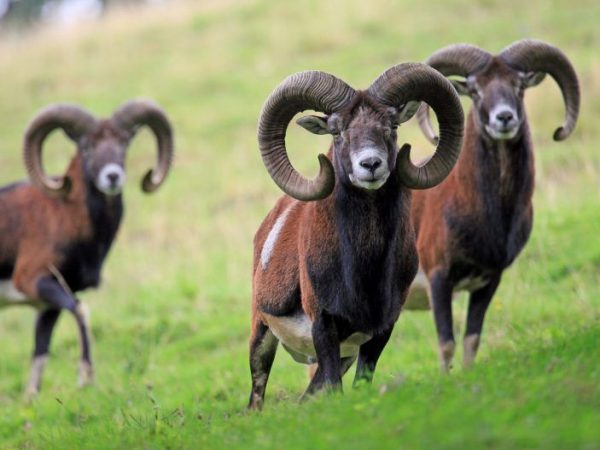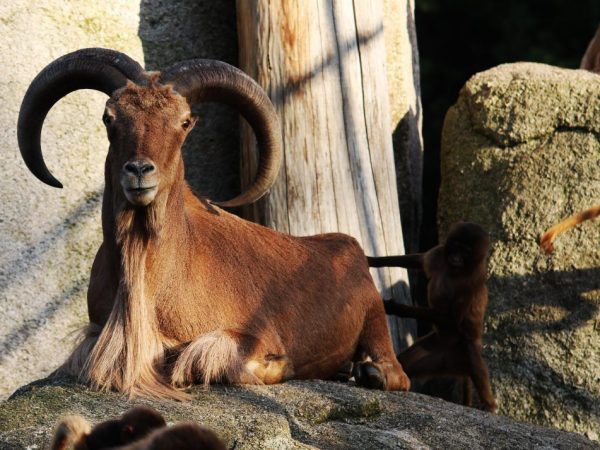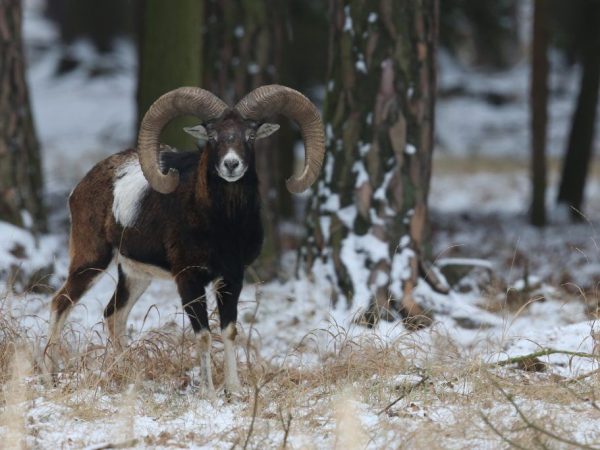Description of the mountain ram mouflon
Mouflon is one of the oldest representatives of the animal kingdom. These artiodactyls are considered the ancestors of the domestic sheep. Even those who have never seen a wild ram will be able to recognize it by its characteristic rounded horns.

Characteristics of the mountain sheep Mouflon
Wild mouflons are widespread throughout Eurasia, however, due to the unusual structure of the horns and the valuable fur coat, they are hunted in many countries. The extermination of the animal population by humans has led to the fact that some breeds of Mouflon are placed in the Red Book. Today, such animals are kept in reserves and zoos, and in some countries they are bred at home.
Habitat and species of animals
Mouflon is a herbivore cloven-hoofed animal, whose habitat is predominantly mountainous. These rams are considered the ancestors of domesticated sheep and are considered one of the most ancient representatives of the animal world.
There are two main varieties of this breed, which differ in exterior and habitat:
- European mouflon;
- Asian wild Mouflon, or Arcal.
The European breed of artiodactyls inhabits the mountainous coasts of the Mediterranean Sea, in particular, its representatives inhabit:
- Cyprus;
- Sardinia;
- Corsica.
The European Mouflon lives in Armenia and Iraq. This breed can also be found in the Crimea, where it was brought from southern countries. Mouflon has adapted to the Crimean climate, and leads a semi-free existence in reserves. In European countries, it is considered the last mountain sheep living in its natural habitat.

European Mouflon
The Asian wild ram differs from the European species in a more massive body structure, in addition, the horns of the representatives of the eastern wild ram curl back, and not on the sides. You can distinguish between European and Asian mouflon by the photo.

Asian Mouflon
The range of the eastern artiodactyl is southern Asia. Mouflon is found in countries such as:
- Tajikistan;
- Uzbekistan;
- Turkey;
- Turkmenistan.
Arkal is also found on the territory of Kazakhstan, the locals of which worship this artiodactyl. The Ustyurt ram is found in the steppes of Mangyshlak and Ustyurt.
The nature and lifestyle of wild sheep
Artiodactyls prefer a migratory way of life. The route of their movement is usually laid between watering holes and pastures. Animals live in gentle mountainous terrain. Unlike wild goats, Arkaly feel insecure in rocky regions.
Wild rams are nocturnal, sleeping in mountain gorges or forest plantations during the day. Females with lambs create a herd of up to 100 heads.
Males prefer a solitary lifestyle, joining the herd during the mating season. Artiodactyls are characterized by a strict hierarchical system: males under 3 years old are not allowed to mate and larger individuals are driven away.
In the wild, the animal's natural enemies are predators such as:
- Steppenwolf;
- Wolverine;
- Lynx.
For young animals, a fox or a wild dog can be dangerous.
Artiodactyl exterior
Representatives of the European breed are smaller in size than a domestic sheep. Artiodactyls of this species have the following characteristics:
- The height of an adult ram is 90 cm, body length is about 131 cm.
- The female weighs up to 30 kg, the male usually weighs about 50 kg due to the heavy horns.
- The age of the animal is determined by the ring-shaped growths on the horns.
- The female is usually hornless or has small horns.
- The hair of a cloven-hoofed animal changes color, depending on the season: in summer the hairline has a red color, in winter the shade becomes darker.
Mouflons are characterized by a black stripe on the back. The belly, nose and hooves are usually light in color.
Representatives of the Asian breed have a more massive body structure, and also the beard on the muzzle is characteristic of the Armenian mouflons. The exterior of the oriental wild ram includes the following features:
- The height of an adult animal reaches 95 cm, and the body length is 150 cm.
- The weight of the male varies from 53 to 80 kg, depending on the weight of the horns. Females reach a weight of 45 kg.
- The horns of the males curl backward, and have a diameter of up to 30 cm at the base.
- Females are most often hornless.
The coat color of the Arkalov is similar to its European relatives, but the eastern breed is characterized by a white color of the sternum.
Wild Sheep Diet
Mouflons are herbivores; therefore, cereals and herbs constitute the main part of their diet. The animal is often found on crops, thereby harming the crop.
The usual diet of an artiodactyl consists of the following components:
- green fodder: feather grass, wheatgrass, sedge;
- shrubs and young trees;
- mushrooms and berries;
- moss, lichen.
In winter, artiodactyls extract plant roots from under the snow. Wormy berries and volunteers are valued as herbivores, as they provide the Mouflons with the necessary proteins.
Reproduction of artiodactyls
Mouflon females reach sexual maturity at 2 years, which is considered the fastest maturation among other representatives of artiodactyls. Pregnancy lasts 5 months, after which one or two lambs are born.
Cubs get to their feet on the first day and are able to follow the herd. Most often, the birth of offspring falls in March and April, since it is easier to raise lambs in the warm season.
The average lifespan of a wild ram is 15 years. European mouflons breed better in captivity. Unlike the European, the Asian wild Mouflon does not reproduce well in zoos.
Mouflon and man
The European breed of wild sheep is actively used in breeding. On the basis of this species, new breeds of domestic sheep have been developed, which are capable of grazing year-round in mountain pastures. The meat of the European artiodactyl has good taste, and the leather is used in light industry.
In winter, the hair of the animal becomes thick and dense, therefore fur coats are made from Mouflons in northern countries. Due to the large number of positive qualities in some countries, not only the hunt for wild mouflons is carried out, but also the breeding of animals on farms.
Conclusion
The Asian wild Mouflon has characteristics with fewer positives. The meat of the oriental ram Mouflon has a low nutritional value and is mainly used for sport hunting. However, some species of the animal are protected by security authorities.
The Armenian wild or Transcaucasian mountain sheep is in the Red Book, as hunting for Mouflon and environmental pollution have reduced the animal population.


